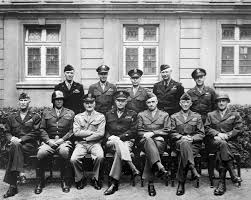At some point, every officer embarking on his or her first tour at the operational or strategic level experiences a level of trepidation. Indeed, leaving the comforts of tactical level planning can be a scary ride. Higher echelons of planning push people to level of mental discomfort they have rarely contended with in previous jobs. The following is a litany of advice on attaining success at higher staff levels.
First, get into a strategic mindset. This means staff officers should take the time to think about big problems, big ideas, and big solutions. Taking the time to pull away from daily business to reflect on the larger aspects of problem sets is the difference between mediocre and high levels of talent. This reflection time does not come easy, and high quality planners will ensure they plan for their periods of reflection, and ensure their subordinates get the same.
Further considerations in the strategic mindset are reframing understanding of time. At operational and strategic levels, the decision cycle slows down. When compared to decisions at the tactical level, getting a 4-star commander to make a decision can take eons. Moreover, attaining decisions from strategic leaders often means obtaining consensus within the rest of the staff. This takes time. Luckily, it takes time to get onto the calendar of said decision makers, which allows ample time to build the required consensus.
Gaining consensus should not sacrifice the quality of the product. Planners must understand and consider which hills to die on when moving papers and briefings through review. Solving issues at the action officer or O6 level is typically the best course of action. However, planners should cultivate an understanding on what is non-negotiable for their directors. When appropriate, let the flag officers have the discussion, and wait patiently for their guidance.
The consensus aspect is an underrated part of planning. The best officers know whose opinions are valued by the commander, and those whose opinions are nice to have. Some of this is dictated by personality, and sometimes this is dictated by position. For example, the public affairs section and the operational law section should comment on nearly every product or plan. Indeed, senior leaders will often ask at the onset of a presentation what legal or public affairs thought of the plan or product.
A frustration that senior leaders continually express is the lack of officer’s ability to produce anything beyond a PowerPoint presentation. In today’s force, read-ahead books filled with 150 pages of slides are all too common. This leads to a second key to success at higher echelons…the ability to write. Operational and strategic level planners cannot rely on PowerPoint skills to get them through their time. The best planners communicate complex ideas through the written word. Planners exercise their power though writing commander’s estimates, position papers, information papers, and white papers. Moreover, these papers must be succinct and to the point.
Pride cometh before the fall. In terms of writing, planners quickly learn that writing is a team sport. Every directorate and division within a staff must have the opportunity to comment on as well as concur or non-concur on every paper. Although papers that reach decision makers contain input from multiple people, there is one primary officer responsible for the paper. Key to navigating this nuance is writing fast enough to ensure all interested parties have the time to review and comment. Avoid emotional attachment to staff papers.
If you want to become a better writer, the first step is reading. If you find yourself assigned to an operational or strategic level staff, chances are you made the decision to become a lifer. Like it or not, the military is your career, and as a career officer you have a duty to continually mold your intellectual apparatus. This means reading.
Reading is not limited to professional journals and books. Staff officers must remain current on relevant joint and service doctrine. Officers on joint staffs should take the time to read new army, navy, air force or Marine Corps doctrine. Officers in a service level assignment should take the time to read both joint doctrine and concepts. Further, planners need to read new national level guidance such as the National Security Strategy or National Defense Strategy.
Planners at higher echelons of command should form their own professional development-reading list. This should include daily news articles, professional journals (both hard copies and internet sites), books covering a wide range of subjects from fiction to history, to economics, and warfighting.
Planners should invest their time improving briefing skills prior to their first day at an operational or strategic level staff. The old saying “you never get a second chance to make a first impression” holds steady vis-à-vis senior leaders. Fouling up a briefing early in an assignment often has cascading effects that will minimize the impact of a planner throughout his or her tour. It is vital to rehearse every brief, and to anticipate questions from the audience. Unlike tactical level briefings, those sitting around the table will have less knowledge on a subject than the briefer. Questions are not meant to test the briefer, but rather to develop a better understanding of a problem or a solution. In this aspect, “I don’t know” is better than providing inaccurate information.
Knowing the audience is a universal aspect of public speaking. The first brief should never be the best brief. Over time, the best planners adapt their briefing style to the desires of their senior leaders. Some senior leaders may pepper a briefer with questions on every slide; others will hold their questions until the end of the brief. Further, you will find that many senior leaders take the time to read their read-ahead packets, and skip right to the questions at the onset. As a planner, never shy away from asking other members of the staff with briefing experience how key leaders like their briefings.
The best planners are subject matter experts in their own respective areas. This seemingly obvious statement has a deeper meaning. An Army officer serving on a joint task force or combatant command staff needs to be the expert in all things army. A signal officer should be able to speak about the capabilities of a brigade combat team (BCT) just as well as an infantry officer. Ditto for the Navy officer who needs to have a base of knowledge on carrier strike groups as well as subsurface warfare. The days of only knowing your own branch, or specific service job are long gone.
Show up. Wayne Gretzky once said, “You miss 100 percent of the shots you don’t take.” In a similar manner, you miss 100 percent of the information that comes out of a meeting you do not attend. The battle rhythm of every joint command fills up with a multitude of meetings. It is prudent to sit in on as many as you can. The various working groups and ongoing OPTs will help any planner in their ability to understand the commander’s priorities and major issues affecting the command. Further, attending meetings will allow a planner to offer their input into various projects as a way to advance their own priorities. Do not wait for an invitation to these meetings, and don’t wait for your boss to tell you to attend. This is a critical aspect of making yourself relevant.
Think for yourself. At the combatant command and joint staff level, you can not simply sit around waiting for higher commands or authorities to tell you what to do. Planning never stops, and the best planners are a step or two ahead of higher organizations. Indeed, when a lower echelon of command is further ahead in planning than higher, it speaks to the confidence and ability of its respective planners. Moreover, don’t assume planners at a higher level are any more competent or informed than you are. Speak up and challenge what you know is wrong and misguided. Higher level guidance is not gospel.
Measures for success
At an individual level, the first measure of success is the speed at which your staff actions are approved. Over time, written products such as information papers or decision briefs will make their way through the approval process with minimal changes. Nothing ever gets through an entire “chop” with zero remarks or changes, but the successful staff officer develops a knack for
The first measure of a successful staff officer is knowing whether or not people rely on you for information. If you find other members of the staff constantly coming by your desk for advice and information, or if other members of the command consistently call you asking for products, then you have attained success. When flag officers or the commander ping your desk, then your success is at a completely new level.
Successful staff officers are in high demand. More than a gathering around a desk, successful staff officers tend to have their calendars full. This occurs as the best staff officers get invited to other working groups and operational planning teams. The successful staff officer is not invited as a subject matter expert, but rather as someone who has developed a reputation for solving problems. People know rather quickly who they want applying brainpower to their
Finally, C.S. Lewis once described an inner ring. Belonging to this inner ring meant “It is tiring and unhealthy to lose your Saturday afternoons: but to have them free because you don’t matter, that is much worse.” Indeed, it is better to work on a weekend, than deemed irrelevant to solving a problem at hand. Successful staff officers know the call is coming.

















